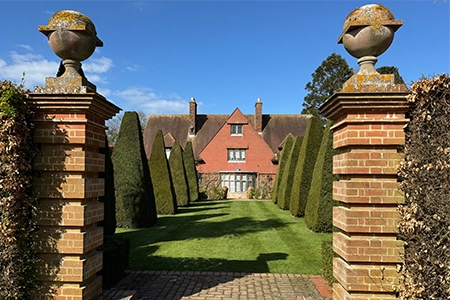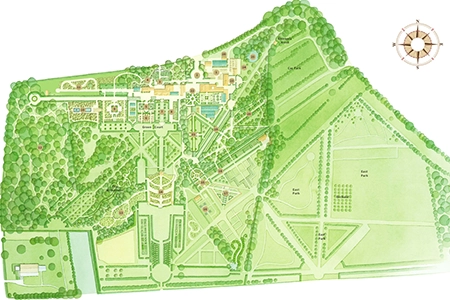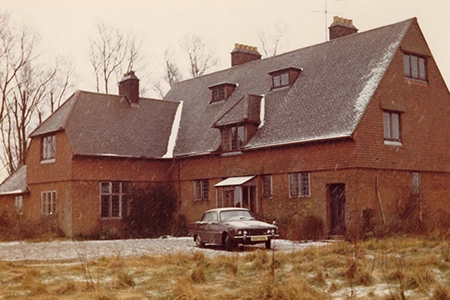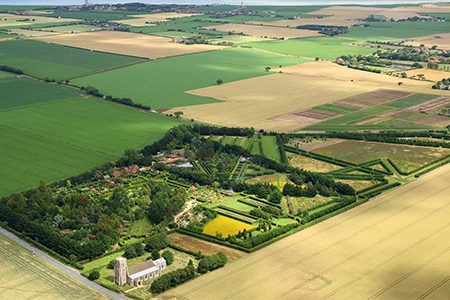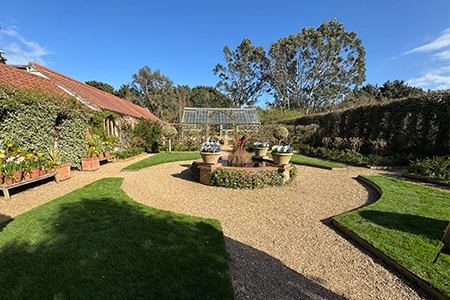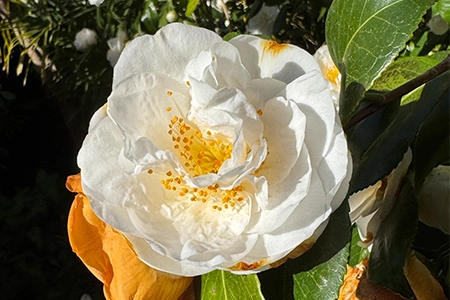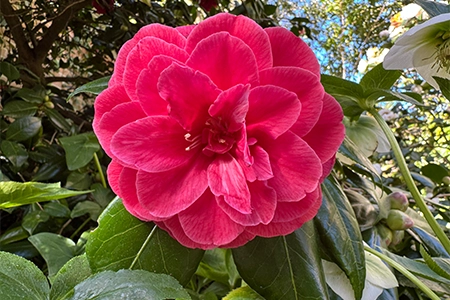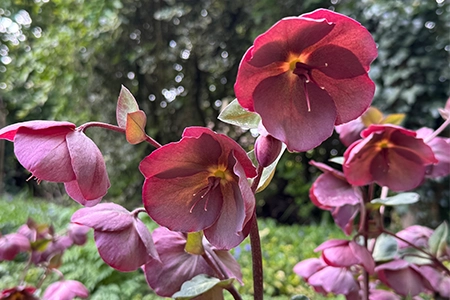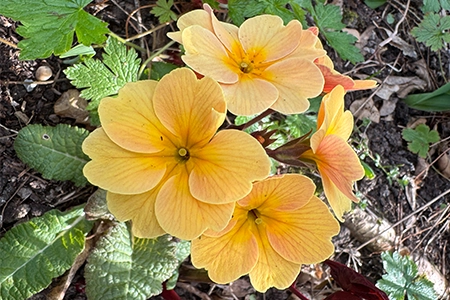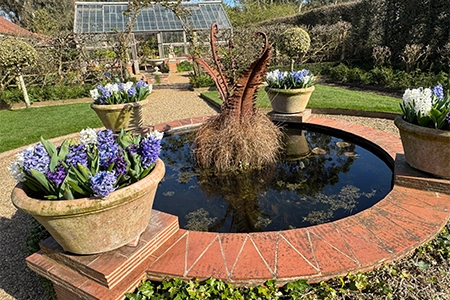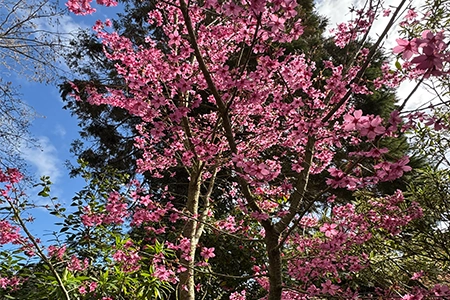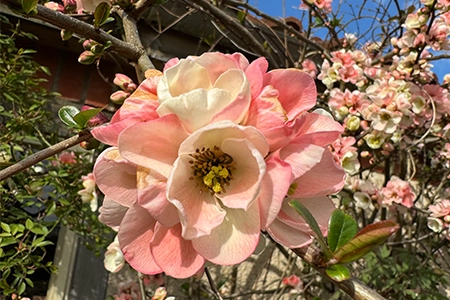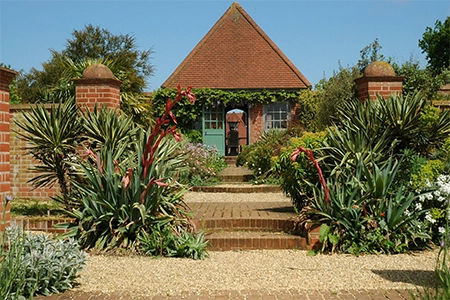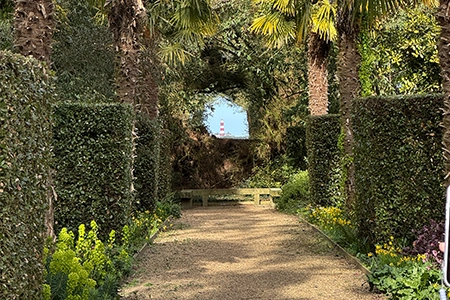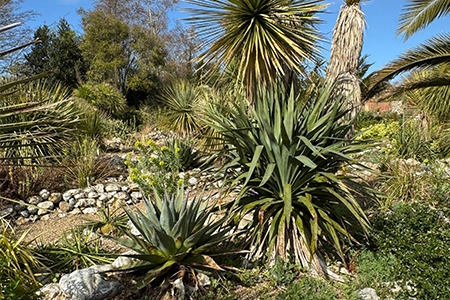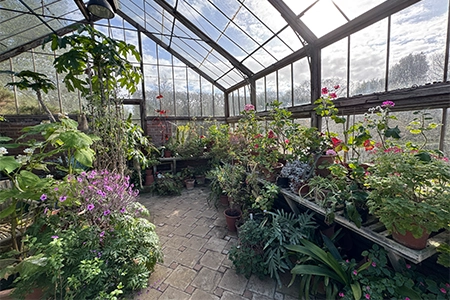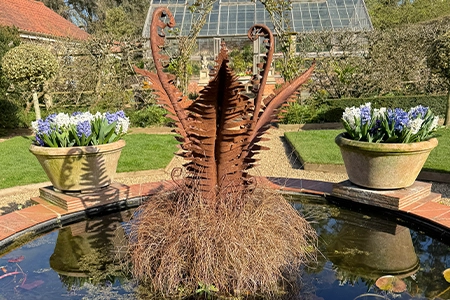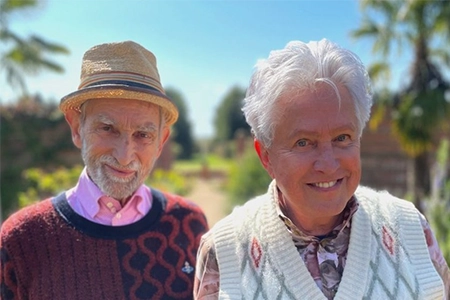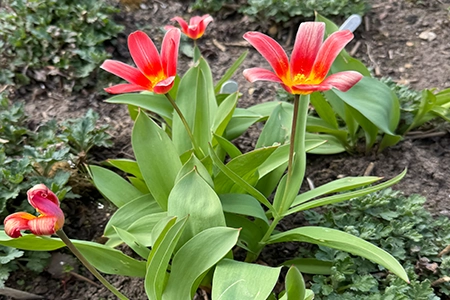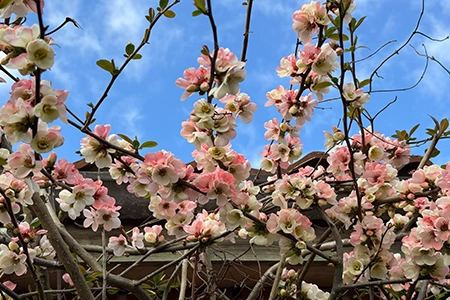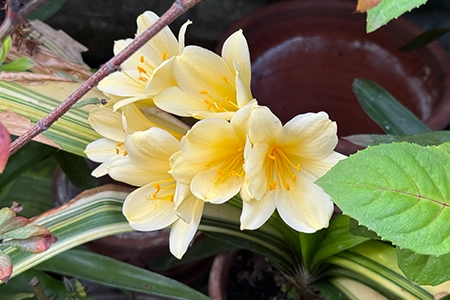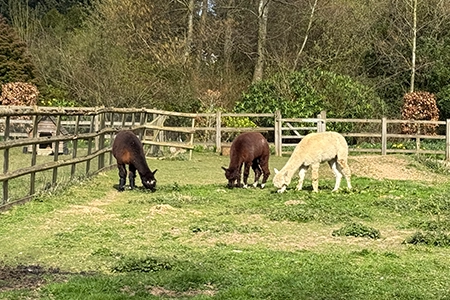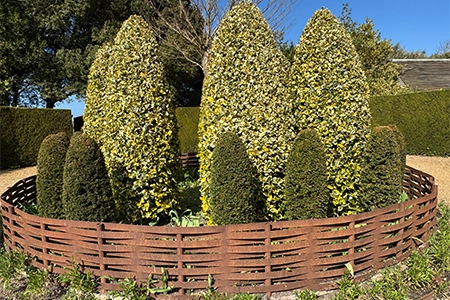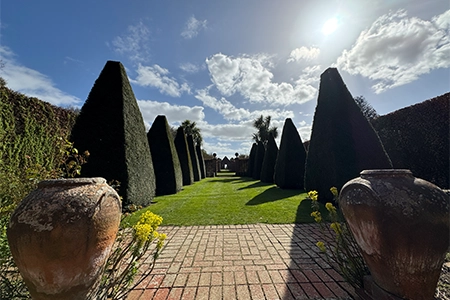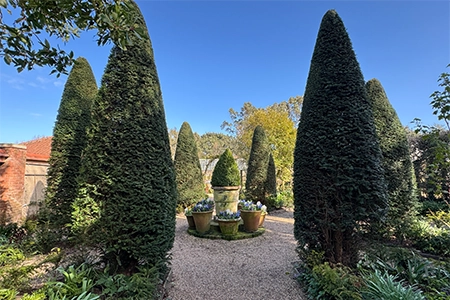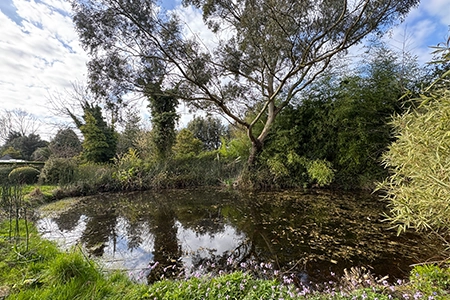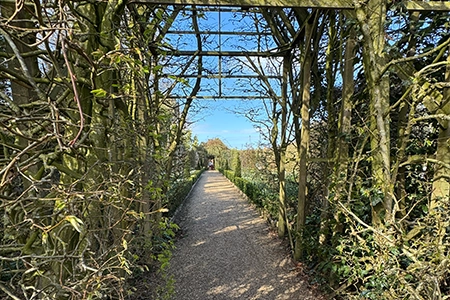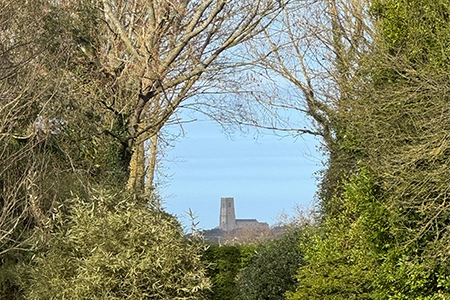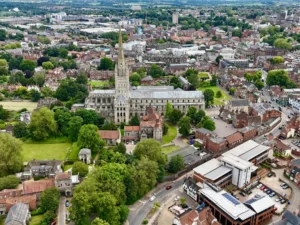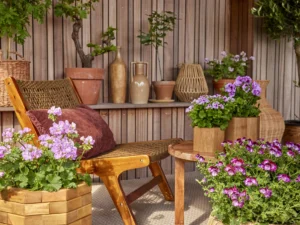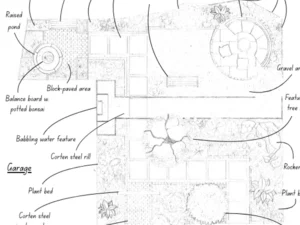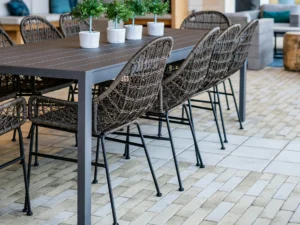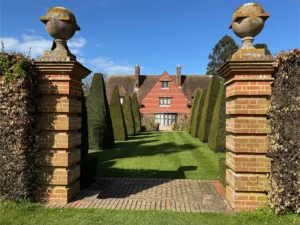The East Ruston Old Vicarage Gardens is a captivating blend of history, horticulture, and artistry. Tucked away in the peaceful Norfolk countryside, just a stone’s throw from the coast, lies one of the UK’s most extraordinary private gardens.
This 32-acre masterpiece is the lifelong work of two passionate and visionary gardeners, Graham and Alan, who transformed what was once a blank canvas into a garden paradise rich with variety, imagination, and soul. Visiting in spring reveals a particularly enchanting side of this space, a time when new life awakens across the grounds and the garden’s structure and design shine.
A Map of the Grounds
With 32 acres of beautifully designed garden rooms, winding paths, and hidden surprises, it’s easy to lose yourself in the magic of East Ruston Old Vicarage. Below is a map of the grounds to help you get your bearings and plan your own route through this horticultural wonderland.
The image was taken from the East Ruston Old Vicarage website.
A Garden Born from Grassroots
When Graham and Alan first discovered the Old Vicarage in 1973, it was nothing more than a derelict house surrounded by wild, overgrown fields of tufted grass. There was no garden to speak of, just potential and a lot of it. At the time, both men were working in London and would make the weekly pilgrimage to Norfolk every weekend.
That dedication paid off. Starting with just two acres, Alan and Graham began planting, nurturing, and designing with quiet determination and boundless creativity. By the late 1980s, they had moved to East Ruston full-time and began expanding the garden into neighbouring plots, guided by historical field boundaries and a desire to recreate habitats lost to modern agriculture.
From this ethos came shelterbelts of pine and eucalyptus, wildlife ponds, and the creation of microclimates, which are essential in this windswept part of the country. What began as a place to walk their dogs has become a destination admired by thousands of garden lovers each year.
The image was taken from the East Ruston Old Vicarage website.
The Garden Today
Today, the East Ruston Old Vicarage Gardens are a rich mosaic of distinct ‘garden rooms’, each with its personality, planting style, and atmosphere. Visitors can stroll through a sunken rose garden, find exotic foliage in the Desert Wash, breathe in the scent of citrus in the Mediterranean terraces, or sit quietly under the shade of Indian Bean Trees in the tranquil Catalpa Garden.
From formal parterres to lush woodland, every inch is lovingly curated. Notable highlights include the dramatic King’s Walk, a formal sequence of lawns and gate piers leading to a striking pavilion, and the Glasshouse Garden, with its thoughtful planting combinations and nostalgic pelargoniums.
The Exotic Garden bursts with tropical flair, while the Dutch Garden showcases bold seasonal displays. There’s even a Vegetable & Cutting Garden, where flowers are interplanted with herbs and produce, celebrating both form and function.
The image was taken from the East Ruston Old Vicarage website.
Springtime Wonders
Visiting East Ruston in spring offers a front-row seat to the garden’s awakening. With many of the later-blooming stars still tucked away, springtime reveals the garden’s bare bones in the best possible way, showcasing structure, texture, and the clever artistry of its layout.
Throughout the Spring Walk, delicate carpets of snowdrops gave way to early daffodils and emerging perennials. In the Woodland Garden, Silver Birch trees filtered soft light over drifts of spring bulbs, while newly unfurling leaves glowed in fresh greens and bronzes.
The Sunk Garden was already coming to life, with alpine troughs sparkling with seasonal gems, and the Glasshouse Garden’s early tulips and spring containers added delightful pops of colour. Around the Wildlife Pond, frogs were active, birdsongs echoed, and fresh green shoots hinted at the life ready to burst forth in the weeks to come.
Stars of the Show
Spring at East Ruston Old Vicarage is a season of awakening, where the garden begins to stir with vibrant colour, delicate fragrance, and bold textures.
While many of the garden’s more tropical residents wait for warmer days, spring offers its own brilliant lineup of floral highlights. Below is a selection of some of the best flowers in bloom at this time of year, each one adding its own touch of beauty to the ever-evolving landscape:
- Camellia japonica
- Helleborus
- Narcissus (Daffodil)
- Primula (Cowslip)
- Hyacinthus
- Tabebuia serratifolia (Ipe)
- Chaenomeles speciosa (Flowering Quince)
Camellia japonica
Scattered gracefully throughout the garden, Camellia japonica thrives in a variety of settings, from dappled shade to more sun-exposed areas. Their glossy, evergreen foliage forms a rich backdrop to the elegant blooms, which ranged from soft blush pink to creamy white during the spring visit.
These shrubs added architectural structure while still feeling delicate, with flowers that looked almost painted in their precision. Nestled against taller hedging or standing alone, the camellias brought a refined calm to the more formal spaces, while still feeling at home in the looser, woodland-style areas.
Helleborus
Tucked low to the ground, Helleborus, or Lenten Roses, brought a quiet beauty to the garden’s shadier corners. Their nodding blooms came in moody purples, soft greens, and antique whites, each bloom like a hidden gem waiting to be discovered. Particularly striking beneath the tree canopies and against the bamboo stems on either side of the meandering entrance path.
They seemed to thrive in the calm, cool spaces where little else dared to flower. They were the perfect groundcover companions, naturalising effortlessly and adding texture and softness to the darker, more secluded garden rooms.
Narcissus
No spring scene would be complete without the joyful presence of Narcissus. At East Ruston, they didn’t disappoint. Found in generous drifts across the gardens, their cheerful yellow and creamy tones added rhythm and warmth to the landscape.
Particularly evocative in the woodland settings, they seemed to mimic wildflower meadows, natural, spontaneous, and completely enchanting. Whether standing tall along winding walks or nestled among early-blooming shrubs, their golden hues lit up the landscape and added a fresh, optimistic energy to every space they touched.
Primula
Versatile and charming, Primulas were on proud display throughout the garden. In the woodlands, the Primula veris offered a naturalistic splash of yellows and pinks, mingling effortlessly with ferns and early spring bulbs. In the greenhouses, more delicate and colourful varieties awaited their moment, ready to be transitioned into pots or borders as the weather warms.
In a delightful twist, a bolder species of purple primula japonica was even used within the Desert Wash, showing just how creatively this plant can be placed. Whether featured in mass or tucked singularly into a corner, primulas brought an approachable, nostalgic beauty to the gardens.
Hyacinthus
Fragrant and full of personality, Hyacinths brought their signature scent and punchy colours to several key areas. In the Apple Walk & Happisburgh Church vista, they lined the base of espaliered apple trees, contrasting beautifully with the brown bark and adding life to the borders.
Their placement in the Sunk Garden, however, was especially memorable, used in abundance around the walled raised pond, they created pops of purple and white. The dense, upright spikes of the hyacinth flowers echoed the vertical lines of the metal water sculpture, their bold form and vibrant hues adding a striking contrast that heightened the drama at the centre of the pond.
Tabebuia serratifolia
A tropical surprise in a Norfolk spring, the Tabebuia serratifolia made a bold impression with its eye-catching golden blooms. Located along the Entrance Drive and Courtyard Walk, these trees offered bursts of sunshine against the steelwork and clipped evergreens of the entrance area.
Their vibrant pink flowers stood out spectacularly in the spring light, offering a playful nod to more exotic climates and showcasing just how diverse the plant palette at East Ruston can be, even in early spring.
Chaenomeles speciosa
Without a doubt, one of the showstoppers of the visit, Chaenomeles speciosa, stole the scene in the Sunk Garden. Its brilliant pink and soft white blossoms sprawled elegantly along a warm red brick wall, catching the sun and drawing every eye. Against a crisp blue spring sky, the contrast was striking, like a living painting.
The quince framed the space beautifully, adding both a sense of nostalgia and structure. Its early blooms provided a joyful burst of colour and a clear reminder that East Ruston is a garden filled with thoughtful design and perfectly timed seasonal impact.
Through Garden Rooms and Hidden Vistas
One of the great joys of East Ruston is the journey itself, moving from one space to the next with a constant sense of surprise and discovery. Each room is carefully framed with clipped hedges, gates, arches, or pergolas, creating sightlines that invite you forward while always giving you something to pause and admire.
We passed from the soft serenity of the Orangery Border, where hedges framed tranquil seating, into the playful structure of the Apple Walk, where espaliered trees rose above a sea of nepeta just beginning to wake up. Through the Mediterranean Garden, the terraces shimmered in the soft spring light, their dry-loving plants basking in the warmth offered by sun-trapping walls.
The image was taken from the East Ruston Old Vicarage website.
A Picture Perfectly Captured
It’s no easy task to choose a single favourite part of such a diverse and inspiring place, but one moment that stopped me in my tracks was in the Winter Garden. Amidst textured bark, berries, and the early stirrings of Cyclamen and emerging bulbs, there it was: Happisburgh Lighthouse, framed perfectly by a circular opening cut into the surrounding trees.
It looked for all the world like a painting, deliberate, elegant, and breathtakingly simple. This moment captured everything that makes East Ruston special. It’s not just about the plants, it’s about how you see them. Graham and Alan have turned gardening into storytelling, and this window was like a final chapter in a book that lingers with you long after you’ve closed the cover.
The Influence of Coastal Climate on Plant Choices
East Ruston Old Vicarage enjoys an unusual climate advantage due to its proximity to the Norfolk coast. This location, just a couple of miles inland, benefits from maritime influences that result in significantly lower frost levels compared to much of the UK.
According to climatology studies by the University of East Anglia, East Ruston experiences average frost levels similar to those of parts of Devon and Cornwall, regions renowned for their mild winters. The garden capitalises on this with an extraordinary selection of tender and exotic plants, like Tetrapanax papyrifera, Bananas, Brugmansias, Echiums, and Palms, many of which might otherwise struggle to survive a typical Norfolk winter.
The magic doesn’t stop at climate alone. The thoughtful design of shelter belts, rows of trees like Monterey Pines and Eucalyptus, provides essential wind protection and creates a warm microclimate throughout the garden. These belts are not only functional but also beautifully integrated, allowing plants to flourish in pockets that mimic more tropical conditions.
Sustainability and Propagation Techniques at East Ruston
While East Ruston might dazzle visitors with rare and flamboyant plants, it’s underpinned by a strong ethos of self-sufficiency and sustainability. Graham and Alan have become master propagators, growing a large percentage of the plants used within the gardens themselves.
This approach not only keeps costs down but also allows them to experiment and refine their planting combinations season after season.
The propagation process is both an art and a science; cuttings, seed sowing, division, and grafting all play a role in keeping the garden thriving. Many of the plants grown on-site are also available to purchase, offering a piece of the garden that visitors can take home.
Art and Sculpture in the Garden
The gardens at East Ruston are a masterclass in design, but not just through planting. Sculptural elements and art installations are seamlessly woven throughout the landscape, adding layers of story, symbolism, and surprise. From the Bill Cordaroy stainless steel and glass sculpture in the Sunk Garden, which represents the owners themselves, to the terracotta coat of arms from the city of Manchester (installed above the Postman’s Gate), there’s a strong sense of identity and intentionality in every artistic feature.
These artworks aren’t just decorations; they function as visual anchors, drawing the eye, framing vistas, and enhancing the garden’s themes. Even the Millennium Gates, monolithic and modern, are a statement, marking time and legacy in equal measure.
The Garden’s Relationship with the RHS
Becoming one of the first six gardens in the UK to be invited into the Royal Horticultural Society’s Partner Garden scheme is no small feat. This accolade highlights East Ruston’s excellence in design, plantmanship, and garden accessibility. Though they receive no financial assistance from the RHS, Graham and Alan use their platform to support the society’s charitable efforts and broader horticultural outreach.
Image taken from the BBC’s website.
Garden Maintenance and Seasonal Planning
With 32 acres of cultivated space, the ongoing maintenance of East Ruston Old Vicarage Gardens is a monumental task. A blog post dedicated to the behind-the-scenes work would give readers an entirely new appreciation for what it takes to keep this paradise looking pristine.
Each season brings a new set of tasks—winter pruning and structural improvements, spring propagation and planting, summer maintenance and deadheading, autumn bulb planting, and constant weeding, staking, mowing, and feeding. The gardens are a hive of activity year-round, with both professional gardeners and dedicated volunteers contributing to the effort.
You could also spotlight how new areas are developed over the winter months and how the garden continues to evolve each year. Seasonal planning involves not just horticultural knowledge but a keen sense of design, vision, and problem-solving.
A Garden That Lives and Breathes
East Ruston Old Vicarage Gardens are more than just beautiful; they are personal, thoughtful, and always evolving. Visiting in spring offers a different perspective, one that shows off the garden’s structure, creativity, and the quiet work going on behind the scenes as it builds toward summer abundance.
Whether you’re a seasoned gardener or simply someone who loves to wander and wonder, this Norfolk gem is a place to return to again and again. And with every season, every visit, there’s something new to see, feel, and fall in love with.
If you’re looking for a garden that delights the senses, challenges the ordinary, and captures the heart, East Ruston is it.
Moments Captured at the Old Vicarage
While words paint a vivid picture, sometimes it’s the little details that truly bring a place to life. Here are some snapshots taken during our springtime visit. We’ve captured some unexpected angles, beautiful textures, and quiet moments that reflect the charm and character of East Ruston Old Vicarage Gardens.

